by Martin Maisel (photos as credited)
One of the key aspects of the EAA is aeronautical innovation – largely focused on small, general aviation aircraft. The story of the tilt rotor is also about innovation by a few people who sought to develop a new vehicle capable of efficient vertical flight, like a helicopter, but with the ability to fly long distances at high speeds, comparable to the performance of fixed-wing aircraft.
Early Tilt Rotor Aircraft
While earlier notions of a tilt rotor type aircraft can be found, a good time to begin this story would be the late 1930s – a time when no practical helicopter had been developed in the USA.
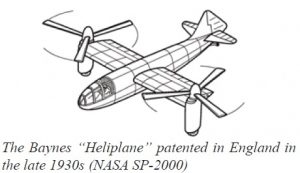 In 1937 Leslie E. Baynes, an English aeronautical engineer, patented an aircraft configuration that employed large diameter propellers on tiltable wingtip mounted nacelles. Baynes was unable to acquire financial backing and his innovative design, intended to provide both vertical and forward flight, never progressed beyond the patented concept.
In 1937 Leslie E. Baynes, an English aeronautical engineer, patented an aircraft configuration that employed large diameter propellers on tiltable wingtip mounted nacelles. Baynes was unable to acquire financial backing and his innovative design, intended to provide both vertical and forward flight, never progressed beyond the patented concept.
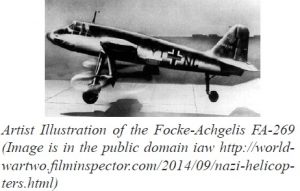 In Germany, during the early years of World War II, the Focke-Achgelis company began the fabrication of mock-up of the FA-269. This tilt rotor design placed the propellers below the wing for vertical flight and, once airborne, the propellers would be tilted to a position aft of the wing trailing edge to provide thrust for forward flight. The purpose of this unique design was to provide the Luftwaffe with a fighter aircraft that did not require runways which may be damaged due to enemy action. The project was discontinued when the mock-up and surrounding facilities were destroyed during an allied bombing raid.
In Germany, during the early years of World War II, the Focke-Achgelis company began the fabrication of mock-up of the FA-269. This tilt rotor design placed the propellers below the wing for vertical flight and, once airborne, the propellers would be tilted to a position aft of the wing trailing edge to provide thrust for forward flight. The purpose of this unique design was to provide the Luftwaffe with a fighter aircraft that did not require runways which may be damaged due to enemy action. The project was discontinued when the mock-up and surrounding facilities were destroyed during an allied bombing raid.
Neither the Baynes Heliplane or the FA-269 advanced the development of the tilt rotor aircraft.
The Path To The Tilt Rotor Aircraft
While inventors and engineers in the United States and Europe strived to demonstrate a practical helicopter since the early years of the 20th century, the task proved to be extremely challenging and no successful vehicle appeared until 1936. 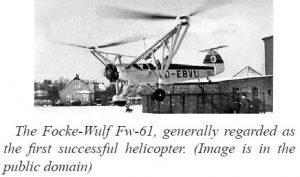 In Germany, the Focke-Wulf Fw-61, with twin rotors mounted on tubular steel outriggers to the left and right of the fuselage, successfully demonstrated a stable hover as well as controllable rearward, sideward, and forward flight (to 76 mph). Those performance capabilities result in the Fw-61 being generally recognized as the first practical helicopter.
In Germany, the Focke-Wulf Fw-61, with twin rotors mounted on tubular steel outriggers to the left and right of the fuselage, successfully demonstrated a stable hover as well as controllable rearward, sideward, and forward flight (to 76 mph). Those performance capabilities result in the Fw-61 being generally recognized as the first practical helicopter.
The success of the Fw-61 attracted the interest of two enterprising American engineers with autogyro experience, Dr. Laurence LePage and Haviland H. Platt. They formed a company with the goal of being the first to produce helicopters in the United States based on the Fw-61 design and approached the German company to acquire rights to build Focke helicopters in the United States. Their attempt to contract with the German company failed because of the deteriorating political conditions between Nazi Germany and the U.S. Nevertheless when a request for proposals for the development and production of a VTOL-capable rotorcraft was issued by the U.S. Army in 1940, the Platt-LePage Aircraft Company submitted the successful bid.
 The Platt-LePage XR-1 with laterally-displaced rotors on outriggers (similar to the proven Fw-61 configuration) therefore became the Army’s first helicopter. However, the Platt-LePage engineers discovered that they did not comprehend the complex technological elements of a helicopter and, eventually, their inability to resolve the XR-1’s flight control, loads, stability and dynamic problems caused that contract to be terminated. The Army then turned to the more successful Sikorsky XR-4 for its first production rotorcraft.
The Platt-LePage XR-1 with laterally-displaced rotors on outriggers (similar to the proven Fw-61 configuration) therefore became the Army’s first helicopter. However, the Platt-LePage engineers discovered that they did not comprehend the complex technological elements of a helicopter and, eventually, their inability to resolve the XR-1’s flight control, loads, stability and dynamic problems caused that contract to be terminated. The Army then turned to the more successful Sikorsky XR-4 for its first production rotorcraft.
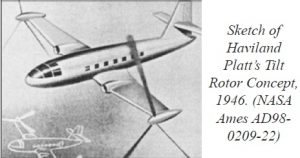 Before the Platt-LePage Aircraft Company folded in 1946, Haviland Platt conceived of a convertible aircraft that appears to be derived from the XR-1. In the patented configuration, that we now recognize as a tilt rotor aircraft, the XR-1 outrigger structures are replaced by wings. The rotors, mounted on the wing tips, were capable of being moved from a horizontal plane (for helicopter operations) to the vertical plane (for airplane flight). It is not known if Platt was aware that a similar configuration was patented in England or that a tilt rotor aircraft was being developed in Germany during World War II.
Before the Platt-LePage Aircraft Company folded in 1946, Haviland Platt conceived of a convertible aircraft that appears to be derived from the XR-1. In the patented configuration, that we now recognize as a tilt rotor aircraft, the XR-1 outrigger structures are replaced by wings. The rotors, mounted on the wing tips, were capable of being moved from a horizontal plane (for helicopter operations) to the vertical plane (for airplane flight). It is not known if Platt was aware that a similar configuration was patented in England or that a tilt rotor aircraft was being developed in Germany during World War II.

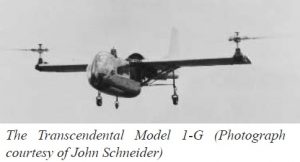
The demise of the Platt-LePage company led to the formation of a new enterprise, the Transcendental Aircraft Company, by Mario A Guerrieri and Robert Lichten. Lichten, a young engineer who previously worked for Platt-LePage and was apparently inspired by Platt’s tilt rotor concept, planned to develop a small flight demonstrator aircraft, the Transcendental Model 1-G. After successfully completing a series of hover and conversion mode tests, the 1-G crashed due to a mechanical control failure. The crash occurred prior to completion of a full conversion to the airplane mode. The aircraft was lost but the pilot survived.
The tilt rotor aircraft had captured the interest of some people in the aviation community, but a convincing demonstration of its capabilities remained elusive.
